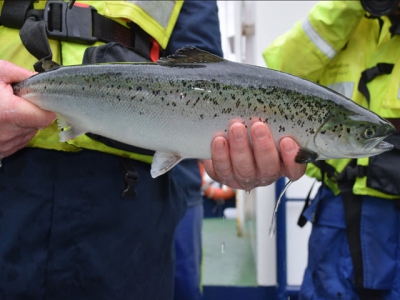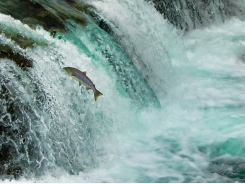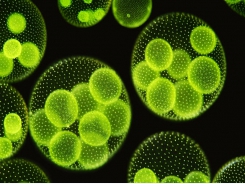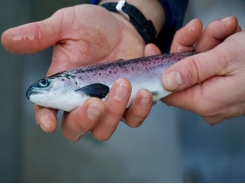Searching for an in-feed sea lice vaccine

A project to develop a pioneering oral vaccine to protect salmon from sea lice has just been launched in Scotland.
Checking salmon for sea lice - a parasite that is thought to cost the Scottish industry £50 million a year
The project, supported with funding from the Scottish Aquaculture Innovation Centre (SAIC), aims to develop a novel vaccine, which can be delivered through fish feed, following recent advances in the understanding of fish immune systems.
Project partners include academics from the Stirling‘s Institute of Aquaculture as well as industry specialists from BioMar; the innovative nanoparticle company SiSaf; and experts in vaccinology, Tethys Aquaculture. The consortium also draws upon the expertise of vaccinologists at the Moredun Research Institute and academic fish immunologists from the University of Maine.
Sea lice pose an enduring challenge for the global aquaculture industry, with a significant impact on fish health and wellbeing. The cost of the parasites to the Atlantic salmon production industry is estimated to exceed £50 million per year in Scotland alone.
The parasites are currently managed and controlled using a range of measures, including veterinary medicines, physical and biological tools for their removal, and optimised farm management practices. Despite existing research and prior testing of injectable vaccines, success has so far been limited, with no commercial solution currently available. Veterinary medicines continue to be employed for control, but the lice are becoming increasingly resistant to treatment.
The new approach to oral vaccination will deliver the vaccine via specially developed feeds that aim to improve fish resistance to parasites using advanced nanoparticle technology. Innovative bio-engineering tools will also target sea lice by triggering strong immune responses in the skin of fish, rather than delivering it through the bloodstream alone. Sharing approaches employed to control ticks in agriculture, the new vaccine aims to directly target the proteins important for the parasite’s survival.
Dr Sean Monaghan from the Institute of Aquaculture, said: “Reducing the impact of sea lice is a major concern for salmon producers around the globe and we are making headway towards finding an effective method for vaccinating fish against this parasite. There is strong evidence to support the use of an oral vaccination approach, using nanoparticles in feed for vaccine delivery in order to trigger the desired antibody response.
“Despite the range of treatment and management tools already in use, sea lice remain a challenge to the industry and increased parasite resistance to drug treatment is reducing the effectiveness of these methods. Development of a vaccine would represent a significant advance in sea lice control, providing a practical, eco-friendly tool for use in an integrated sea lice control strategy.”
Polly Douglas, aquaculture innovation manager at SAIC, added: “Addressing environmental and health challenges, including sea lice, is one of SAIC’s priority innovation areas and a crucial concern for the global aquaculture industry. The work of this project correlates directly with the Scottish Government’s 10-year Farmed Fish Health Framework, aiming to improve fish health, protect the marine environment, and ensure Scotland’s main food export grows sustainably.
“Collaborative research and development projects, such as this, harness the expertise of academia, industry partners and salmon produers, and can play a major role in future sustainability of the industry.”
Related news
Tools

Phối trộn thức ăn chăn nuôi

Pha dung dịch thủy canh

Định mức cho tôm ăn

Phối trộn phân bón NPK

Xác định tỷ lệ tôm sống

Chuyển đổi đơn vị phân bón

Xác định công suất sục khí

Chuyển đổi đơn vị tôm

Tính diện tích nhà kính

Tính thể tích ao




 Plant additive may boost farmed snapper immune response
Plant additive may boost farmed snapper immune response  First salmon smolts transferred from SSF’s new RAS…
First salmon smolts transferred from SSF’s new RAS…